New Delhi: Chicago resident Thomas Murray’s first glimpse of Delhi was through a haze of smog. The city’s famous landmarks were barely visible and each breath seemed like a gamble on health. That was in the winter of 2021 and though the 40-year-old consultant has since returned thrice to visit friends in Odisha, he has made sure to switch up his itinerary.
“IGI Airport in Delhi serves the most nonstop destinations from the US, but I now go out of the way to ensure I am transiting through Bangalore instead,” Murray said. “The air pollution in Delhi is extremely toxic around the time I come in December and January. South India doesn’t seem to have these problems, so I know I will breathe easier, quite literally.”
Given that Delhi airport handles over a quarter of India’s foreign arrivals, the city is the first impression of the country for many. Unfortunately, it’s usually less about the Red Fort and Connaught Place and more about reaching for a sturdy mask. And visitors are already primed to expect the worst. International media regularly paints a grim picture with reports of the “world’s worst air” and “apocalyptic dumpsites.” Bloggers offer “survival guides” for navigating the toxic fumes of Indian cities and online travel forums often teem with anxieties and complaints. For example, a Reddit user recently asked for some “positive stories” about India amid all the negative ones. “I’ve never heard a good thing about it, but I’m interested in it,” they wrote. “I can deal with garbage, but I have a hard time with polluted air.”
Serious safety concerns, particularly for women, also dominate travel advisories and online forums. “Reports of rape and assault against foreign women have increased,” cautions the Canada advisory, for instance, while the US advises women to not travel alone. “Women may face higher levels of verbal and physical harassment or sexual assault,” warns Australia. This perception is reinforced by harrowing news reports.
Type ‘India woman safety’ and the top Google-generated responses are all about whether the country is safe for female tourists
James Stewart, London-based travel journalist
Last Friday, a Brazilian woman on a biking trip with her Spanish husband was allegedly gang-raped by seven men in Jharkhand’s Dumka, sharing her harrowing experience on social media. The hashtag “shameful” trended and a flurry of tweets followed. One user declared that their New Delhi and Goa trip was now “aborted” and another stated that India had “just joined the list of countries I would never travel to”. But when an American journalist highlighted instances of sexual harassment of tourists in India, the National Commission of Women (NCW) chairperson Rekha Sharma, instead of expressing concern, reprimanded him for “defaming” the entire country.
Did you ever report the incident to Police? If not than you are totally an irresponsible person. Writing only on social media and defaming whole country is not good choice. https://t.co/PiDyspKsiU
— Rekha Sharma (@sharmarekha) March 3, 2024
Stories like these are beginning to erode Brand India. At a time when India’s voice and stature on the global stage are on the ascendent, ease-of-doing-business is improving and MNCs, are being wooed to exit China and invest here, concerns over pollution, women’s safety, communal stress are dragging it down.
The number of foreign tourist arrivals into India is dropping. And with negative publicity getting amplified, the tourism industry, which relies heavily on positive word-of-mouth, is suffering suffers.
From 10.93 million foreign arrivals (FTAs) in 2019, visitors to India dipped sharply during the pandemic and the figures are yet to bounce back, with only 6.44 million FTAs in 2022 and 8.16 million by November 2023.
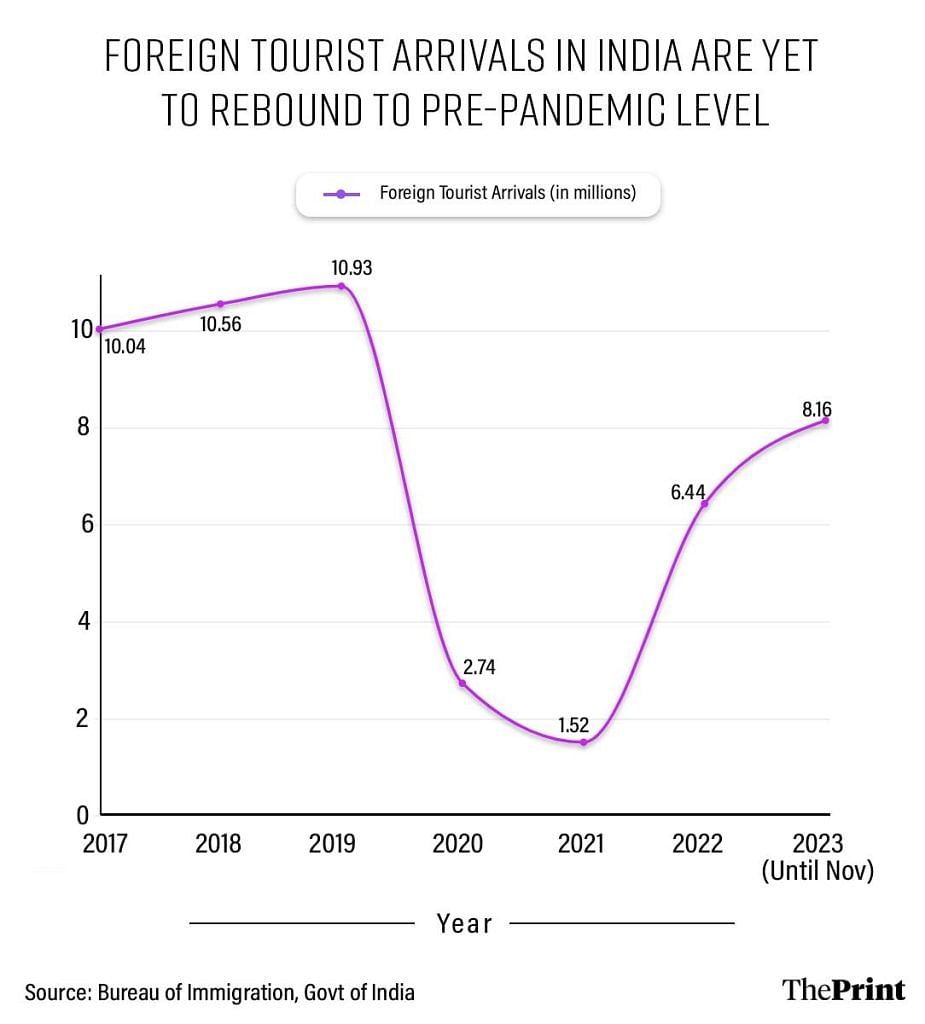
And while global tourism rebounds post-pandemic, India lags behind. The UN World Tourism Organisation (UNWTO) reports a nearly 90 per cent recovery in international tourism for 2023 compared to 2019, but for India it’s less than 75 per cent for the same period, going by Bureau of Immigration figures.
Several visitors and diplomats who spoke to ThePrint expressed discomfort over the issues derailing the India Story, which they said is bigger than just the economic rise.
“Usually, when people travel, they look at advisories, especially when travelling with loved ones. Visits to India have to be more planned than other countries and hence one undertakes wider research,” said a European diplomat. “News of attacks, tensions, pollution, and the experiences of others published in the media can also be unsettling for many. One issue is the communal tension that gets reported. One might not feel that safe.”
The links between chronic pollution, sputtering tourism, and economic losses are well-documented.
‘Unbreathable’
When 22-year-old German student Gregor Lauth touched down in Delhi last August, armed with a backpack and an adventurous spirit, he expected the proverbial heat and dust. But the severity of pollution caught him off guard. “No one told us how bad it was going to be,” he said. Swiftly altering his plans, Lauth spent minimal time in Delhi, opting instead for the less polluted Ahmedabad.
“We had a pretty good time in India, despite it having less facilities for backpackers than other Southeast Asian countries,” he said. “But the pollution is definitely something we spoke about to others who wanted to come to India.”
For years now, there have been sporadic reports about the possible impact of pollution on tourism in the national capital, with a 2017 Assocham report even predicting that “Delhi is bound to drop off from the map of international tourists”. In 2019, Bloomberg reported that business travellers and tourists were cancelling or rescheduling trips to Delhi due to soaring pollution levels. Little seems to have changed five years down the line.
We in Wisconsin value clean air. So, I fear I won’t have the best experience in India. It’s gonna be Nepal, not India for us.
Kavanaugh FitzPatrick, 22, a student planning a South Asia trip
Visitors keep away and many residents now plan trips out of cities in peak pollution months. Some, like financial journalist Jyoti Pande Lavakare have moved base altogether. For Lavakare, author of Breathing Here is Injurious to Your Health, the turning point was her mother’s death due to lung cancer. She and her family bought a house in Goa where they now spend most of their time. “It is not easy leaving your home, but the pollution changed our plans entirely,” said Lavakare, who calls herself a “pollution refugee”.
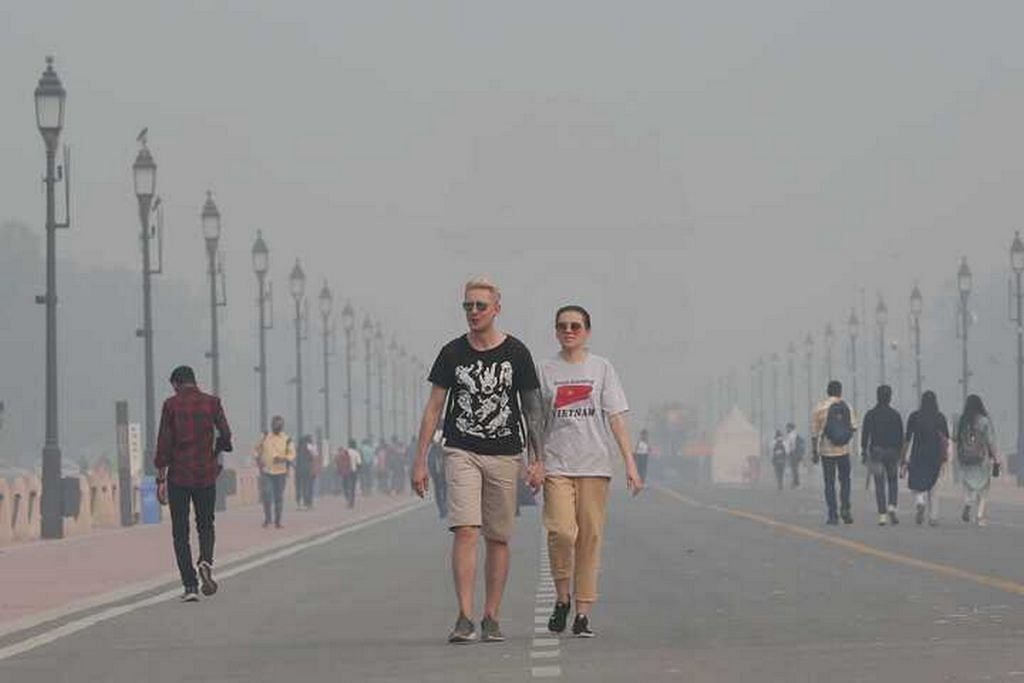
But, in India, options for escape are limited for those seeking fresh air and azure skies. Thirty-nine out of the world’s 50 most polluted cities are in India, according to the latest World Air Quality Report by Swiss company IQ Air. While most fall in the Indo-Gangetic plain, other major metropolises like Mumbai and Kolkata frequently feature in the top 50 of IQ Air’s live rankings.
Mercer’s 2023 Quality of Living City ranking, which takes into account factors like air quality, water, and sanitation, reflects this dismal situation. Out of the total 240 cities, the highest-ranking one in India is Hyderabad at 154. Pune, Chennai, and Mumbai are a few rungs down, while Delhi comes last at 172.
“Despite air purifiers in homes and schools, the air is still so unbreathable,” said a senior diplomat from a G7 country. “Forget children, even grown-ups like me end up with scratchy throats and cough because of the air.”
Even short-term exposure to smog season is something that visitors want to avoid, said Chetan Juneja, a senior executive at travel company Tamarind Global
Is the haze really hitting tourism?
Social media chatter reflects that the world is taking note of India’s pollution problem while making travel decisions. The Reddit post mentioned earlier, for instance, flagged the concern that “India occupies spots 1-15 on the list of most polluted cities in the world”, sparking 264 responses. The overall trend of the advice was to head south and go upscale instead of budget.
In another channel, a user asked if they should cancel their trip to Delhi because of the AQI. Here too, there was advice to travel south or to Goa, with a few disgruntled visitors sharing their experiences too. “I landed for a layover, spent about 2 hrs (in Delhi), AQI around 320,” said one commenter. “I’m cancelling my stay in Delhi, I value my lungs over a few bucks and Instagram shots.”
Tourists anyway prefer exotic locations like Ladakh, Goa, Rajasthan, or Kerala in India where they don’t encounter pollution as much
-Piyush Pandey, advertising expert
Even short-term exposure to smog season is something that visitors want to avoid, said Chetan Juneja, a senior executive at Tamarind Global, a B2B and B2C travel management company. And those who do visit when the haze is high show “a hesitancy to return”, he added.
Anil Kalsi, vice president of the Travel Agents Federation of India, confirmed that pollution deters foreign tourists in Delhi and Mumbai. “However,” he said, “(the situation) is somewhat better in other popular destinations like Agra, Jaipur, Goa, Ladakh, Leh, and Pench.”
All this is counter-intuitive to the narrative of vishwaguru and Incredible India.
Yet, brand gurus insist that dipping tourist arrivals have nothing to do with India, blaming this instead on geopolitical ripples like the Russia-Ukraine and Israel-Hamas conflicts.
“I’ve never seen the brand fly higher than it does now,” said former Ogilvy India chief Piyush Pandey, known for famous ad campaigns like Asian Paints and the BJP’s 2014 ‘Abki baar Modi sarkar’. “The brand of a country is visible in how much respect the world sees you with, and India’s respect is at an all-time high.”
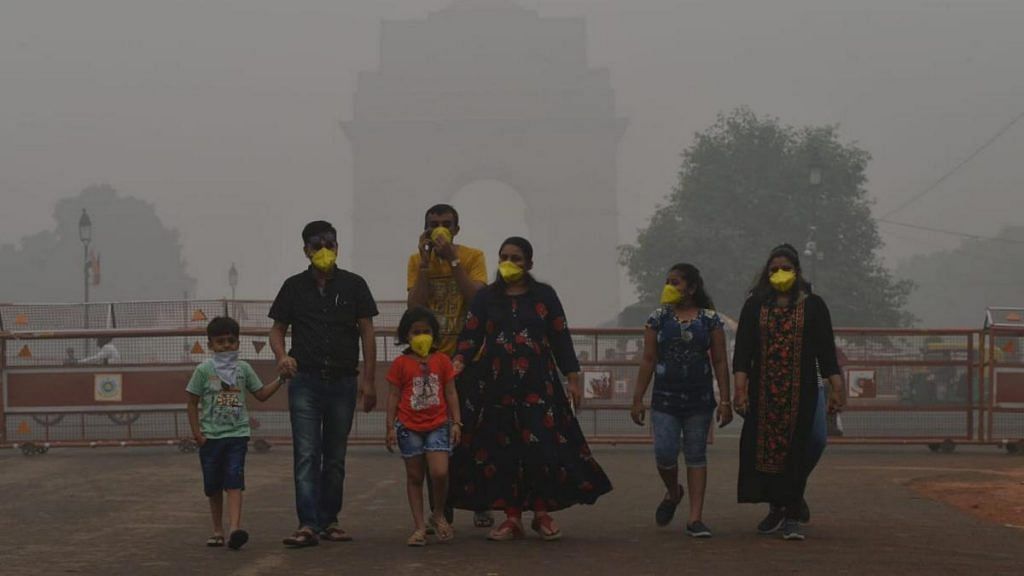
Pandey conceded that the “human reaction” is to avoid places with high pollution, but claimed it wasn’t a factor in declining arrivals. “Tourists anyway prefer exotic locations like Ladakh, Goa, Rajasthan, or Kerala in India where they don’t encounter pollution as much,” he said.
In a similar vein, Ashish Khazanchi, managing partner of Enormous Advertising, claimed that India’s brand is “formidable” and on the upswing. “There could be some reasons for the decline in inbound tourism like the pandemic and global crises like wars. But I don’t think air pollution in India can be a significant factor in tourists deciding not to come to the country,” he said.
Yet, it’s not unreasonable to assume that India’s negative reputation for air pollution has played a part in reducing tourist inflow. The links between chronic pollution, sputtering tourism, and economic losses are well-documented.
For instance, a 2016 survey published in the Journal of Sustainable Tourism shows that China’s air pollution contributed to a decline in inbound tourism in from 2001-2013, a period in which the country was home to 20 out of the world’s 30 most polluted cities. This study also noted a “spillover effect—tourists tended to avoid even the neighbouring provinces of polluted areas.
Brunei Darussalam is another example. In 1997 and 1998, extreme haze and air pollution from Indonesian forest fires blanketed the region. A 2000 study in the journal Economic Analysis and Policy estimated a loss of 1-8 million Brunei dollars to the country’s tourism industry due to these episodes.
In 2021, the climate tech company Blue Sky Analytics released a study, conducted between October 2019 and 2020, documenting the drop in footfalls in commercial and tourist hubs in Delhi in those months. “The high levels of air pollution in the capital city has become a deterrent for tourists and visitors,” it noted, adding that there was a 40 per cent drop in online booking enquiries when PM2.5 levels spiked to over two times the annual average.
“Delhi has also fallen 30 ranks in the annual Global Talent Competitiveness Index (GTCI) which ranks cities around the world on their attractiveness as places to live and work,” the study further said.
Indeed, India as a whole has not practically progressed on this ranking, published annually by the business school INSEAD, going from 83 out of 103 countries in 2013 to 103 out of 134 in 2023.
And being posted to India still comes with a “hardship allowance” for staffers in some embassies, which is another indication of how the country is perceived abroad.
Experiences vary across regions, with tourists generally reporting higher levels of safety and cleanliness in South India.
Safety concerns
Going purely by the grisly news reports about the experiences of foreign travellers, and the red flag advisories issued by the governments of developed economies, a Western tourist in India requires nerves of steel and an appetite for risk.
The gang-rape of the Brazilian woman in Jharkhand is just the latest example, but there have been many other disturbing incidents that received international attention. Striking parallels can be drawn between the recent case and the 2013 rape of a Swiss woman on a cycling trip with her husband in MP’s Datia, where six men were arrested. Last month, a video of a man harassing a South Korean vlogger in Maharashtra went viral; it was the second such incident she recorded. In 2022, a British woman was raped in Goa’s Arambol beach and in 2016, a German woman alleged she was raped by an auto driver in Delhi. And in 2018 two men sexually assaulted and decapitated a Latvian tourist. The list goes on.
“Type ‘India woman safety’ and the top Google-generated responses are all about whether the country is safe for female tourists,” said James Stewart, a London-based travel journalist, adding that this issue is a deal-breaker for many. “It’s not great for how a country is perceived abroad.”
On that tourist couple beaten up and gang raped in India:
It is not safe to travel in India solo as a woman of any nationality. In the course of my work as a historian of India I have been sexually harrassed more times than I can remember, and badly assaulted several times. 1/2
— Dr Katherine Schofield 🇬🇧🇦🇺 (@katherineschof8) March 3, 2024
Additionally, Stewart said, there’s a perception, “rightly or wrongly,” of increasing Hindu nationalism, which, coupled with reports of India’s downgrade in democracy rankings, could have an effect on its reputation abroad. “It may affect people’s perceptions of a welcoming country regardless of the reality,” he observed.
However, experiences vary across regions, with tourists generally reporting higher levels of safety and cleanliness in South India, embassy sources said. Perspectives on safety in North India are not uniformly negative, either.
“As a white male, or ‘gora’, I’ve felt safer in India than in my previous postings across South America,” said a European embassy staff member in Delhi. “There, gun and knife crime were high. Here, I can walk freely in Chandni Chowk or Dilli Haat— it’s a luxury.”
Manisha Saxena, director general of Tourism, underscored the government’s efforts to combat perceptions of India as an unsafe destination. “A number of initiatives like the tourism police, pink police, women helpline number, tourism helpline numbers, introduced by various state governments, underline our commitment to safe tourism, particularly for women travellers,” she said.
However, not only do dire dire news reports keep trickling in, tourism industry leaders said India is simply not spending enough money or effort to polish its brand abroad to attract more foreign visitors.
Tourism officials paint a picture of a steadily waning focus on international travellers, including the shuttering of 20 overseas tourism offices since 2018.
Geopolitical upheavals, budget cuts
While India champions itself as a “360-degree holistic destination” on the global stage, its actions seem to tell a different story. Even as the country grapples with widespread negative publicity about its traveller experiences, plans to enhance tourism promotions and facilities for international visitors seem to be on the backburner for now.
On 1 February, Union Finance Minister Sitharaman slashed the 2024-25 budgetary allocation for Overseas Promotion and Publicity by a drastic 97 per cent. From the Rs 100 crore allocated in the revised estimate, the budget for international tourism was reduced to a paltry Rs 3 crore. In contrast, the domestic promotion budget got a more robust allocation of Rs 176.97 crore, suggesting a shift in priority to homegrown tourism.
Behind the scenes, tourism officials paint a picture of a steadily waning focus on international travellers, including the shuttering of 20 overseas tourism offices since 2018.
“These offices used to conduct promotional activities such as road shows targeting prospective foreign tourists. They were also liaising with local tour operators. With the offices shut, the promotional activities have also stopped,” said a tourism official on condition of anonymity.
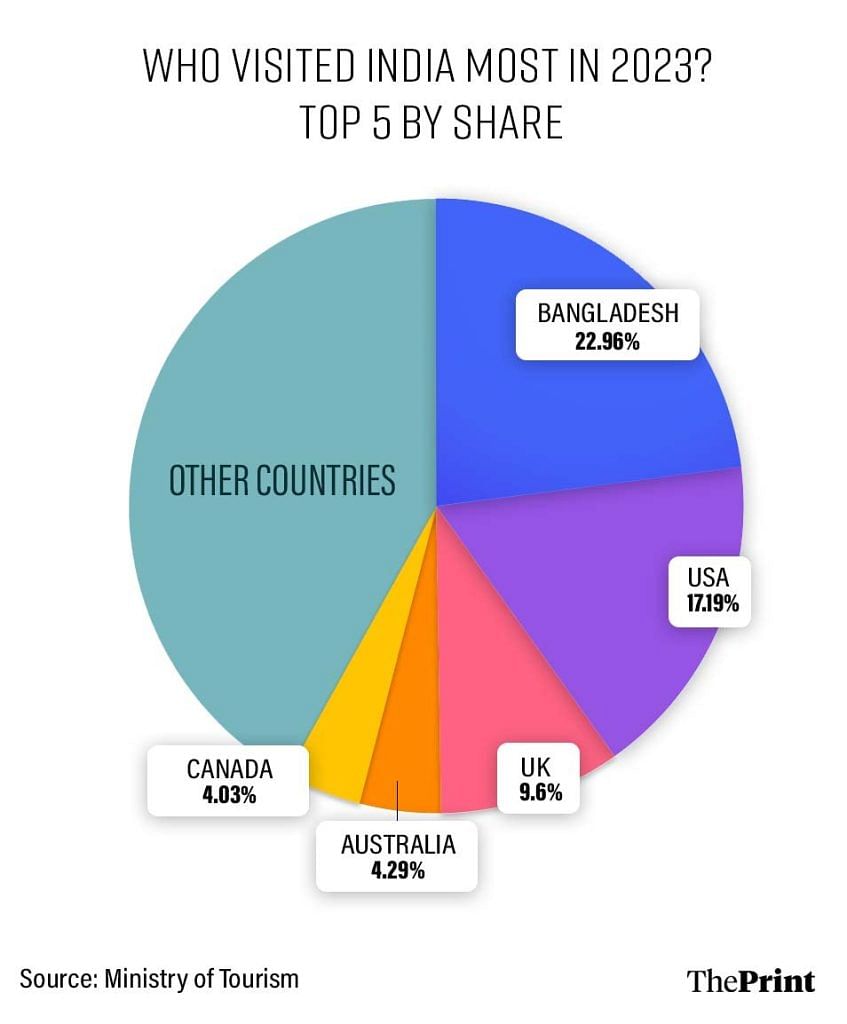
The final straw, according to the official, was the March 2023 closure of the last seven offices in London, Tokyo, Beijing, Dubai, Singapore, New York, and Frankfurt. These have been replaced with a single designated tourism officer within Indian Missions in these source markets. “An IFS (Indian Foreign Service) officer has been appointed as tourism officer with a mandate to promote India as an important tourist destination,” the official added.
The missions too have raised concerns about their capacity to handle the additional responsibility of tourism promotion effectively. “The general feeling of the Indian Missions is that the role of tourism promotion has been allocated to them without proper financial and human resource augmentation,” acknowledged a report tabled in March 2023 by the parliamentary panel on Transport, Tourism and Culture.
At a time when long-distance travel, particularly from India’s key source markets of Europe and the USA, has also been hit by the ongoing wars, these changes come as a blow, pointed out former tourism secretary MP Bezbaruah, currently the secretary-general of the Hotel Association of India.
“Tour operators and travel agents are saying that our marketing has slowed down in the source market, which could have impacted the FTA numbers,” he said. “The slashing of the budget will also have an impact.”
A pivot to domestic tourism at the expense of international could come with several side effects, according to sector experts.
The budget traveller who used to come from Israel is not coming because of the war. The European budget traveller is not coming because they are spending much more on their energy and living cost. But the rich traveller is still coming here
-Anil Kalsi, vice president of the Travel Agents Federation of India
“Domestic tourism is not going to bring you the foreign exchange. Also, most domestic tourism is unorganised, while 95 per cent of international inbound traffic is part of the organised sector,” said Rajiv Mehra, president Indian Association of Tour Operators (IATO). “We are not doing any media campaigns anywhere. Tourism can’t grow on its own unless you promote the place.”
Tourism DG Saxena, however, told ThePrint that apart from the effects of Covid and global conflicts, international tourism was on track, with missions conducting active promotions.
“The visibility of India as a preferable destination is reverberating across the globe after the Indian presidency of G20. The enquiries and requests we received for hosting many important tourism events in India for the next few years are unparalleled,” she said. “Campaigns like Meet in India, Wed in India, Heal in India have given a new resurgence to the tourism sector.”
But private market players are disgruntled and report a decline in the government’s support.
“They used to have incentives for inbound earnings. But the government has stopped it,” said a senior representative from a leading travel company, asking to remain anonymous. “There is no money given to operators for trying to promote India abroad, it’s like you are on your own, this is your business, you do what has to be done.”
Cost factor, and a paradox
The immigration lines at India’s international airports might be considerably shorter, but foreign exchange earnings (FEEs) from tourism are on track to catch up with pre-pandemic levels. For January-November 2023, tourism FEEs reached Rs 2.07 lakh crore, exceeding the Rs 1.93 lakh crore earned during the same period in 2019 (it was Rs 2.16 lakh crore for the entire year).
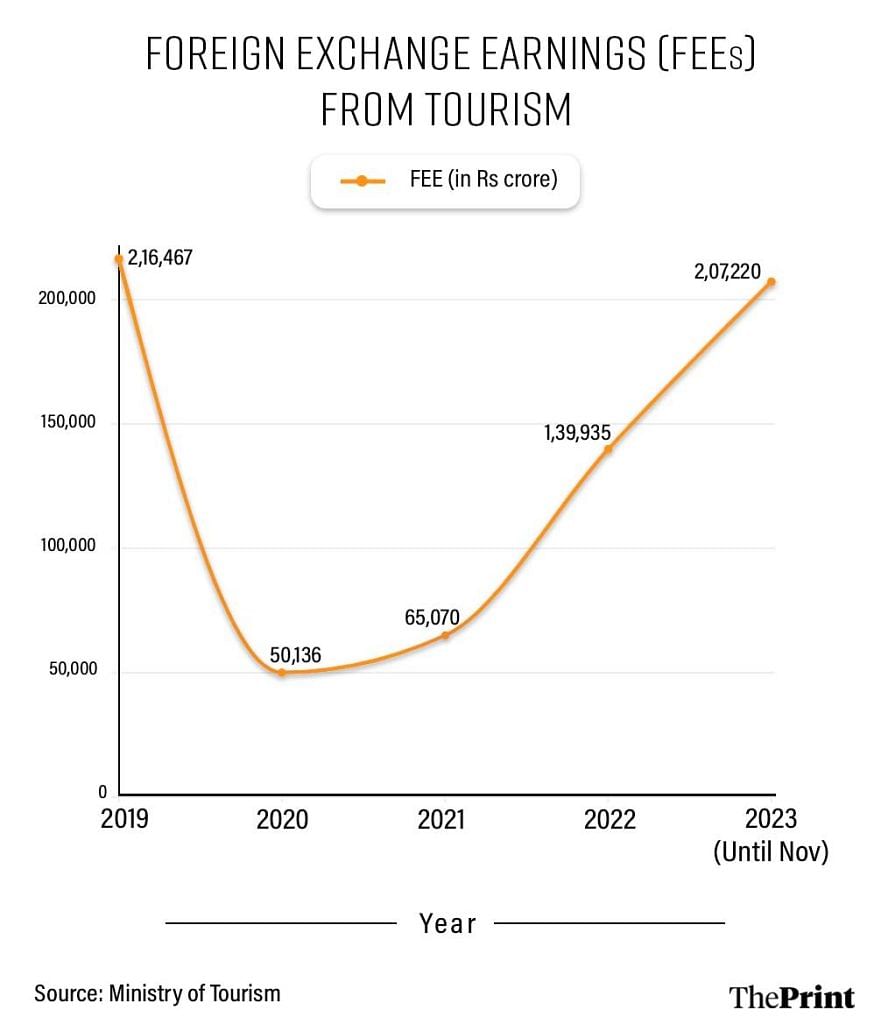
This apparent paradox is because India is seeing a change in its foreign visitor profile, according to industry leaders.
“The budget traveller who used to come from Israel is not coming because of the war. The European budget traveller is not coming because they are spending much more on their energy and living cost,” said Anil Kalsi, vice president of the Travel Agents Federation of India. “But the rich traveller is still coming here. They use the services of specialist travel companies for their experiences.”
IATO president Mehra also observed that India is drawing more “high-end tourists” than backpackers on a shoestring budget. “You have more tourists who are spending much more on adventure, trekking, yoga retreats, buying handicrafts … the spending has increased,” he said.
One reason for this is that air fares and hotel tariffs have seen a spike. Airfares for foreign tourists have increased by 30-100 per cent in the last two years compared to pre-pandemic levels, according to Kalsi. “The domestic demand for hotels has also really spruced up. When you have a tariff that’s much higher than it was pre-pandemic and your inventory is still full, you don’t have a reason to undercut it even for foreign guests,” he added.
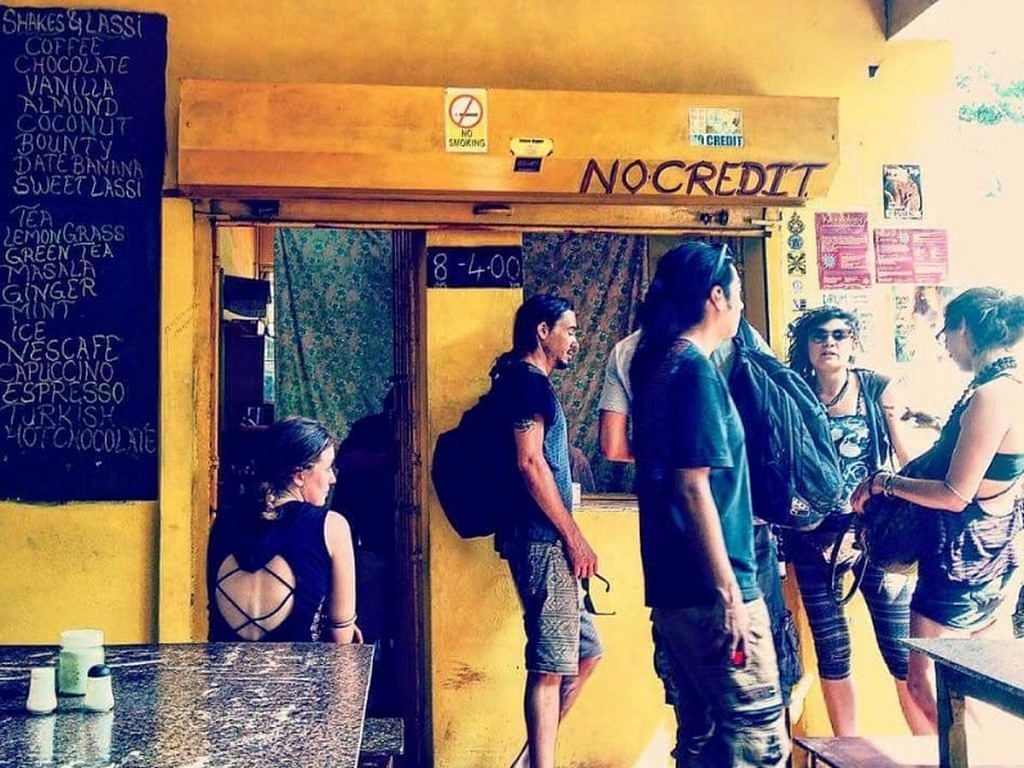
However, while the shift in foreign visitor demographics might boost FEEs, it could pose challenges for the long-term diversity, sustainability, and resilience of the tourism sector, including hotels and other stakeholders catering to different budget categories.
The lack of affordable and mid-range stay options in India deters many people from visiting the country, according to a diplomat from a major European economy.
“Not all tourists are backpackers or rich. There are average people too,” the diplomat said. “Moreover, many tourists’ places don’t have many options when it comes to good mid-range hotels. The options range from 5-star luxury to motel-type places, without much on offer in the middle.”
The competition is fierce too. With Southeast Asian countries offering diverse and budget-friendly experiences, India needs to up its game in both facilities and promotions to attract a wider range of visitors, according to industry leaders. “You have to make a lot of noise,” IATO’s Mehra said. “How are you otherwise going to compete with countries like Vietnam, Thailand, Sri Lanka?”
Meanwhile, Kavanaugh Fitzpatrick, a 22-year-old student and intrepid traveller from Wisconsin, USA, is planning his first trip to South Asia in the coming year. But horror stories about air pollution have impacted his itinerary. “We in Wisconsin value clean air. So, I fear I won’t have the best experience in India,” he said. It’s gonna be Nepal, not India for us.”
(Edited by Asavari Singh)


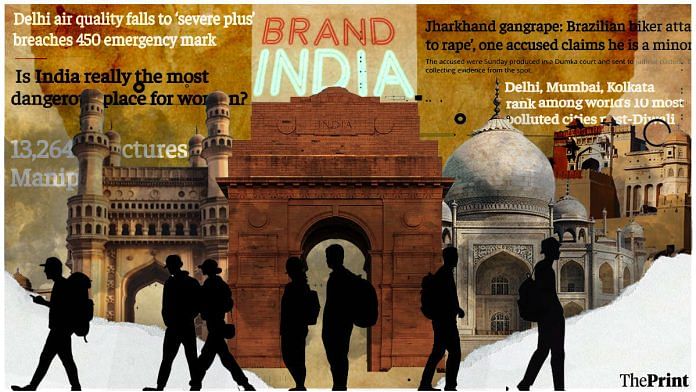

Gang rape of foreign tourists in India must be stopped! Only a death sentence can curb such crimes and save our nation!
The more time BJP rules in the center, the more the inhuman man-made tragedies will be tried to hide under the carpet or accepted as new normal like mob-lynching, and the more India’s brand image getting destroyed.